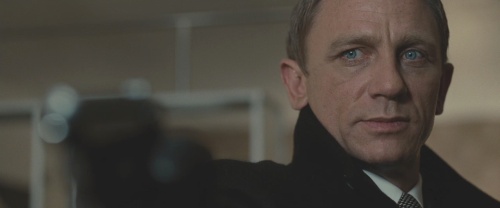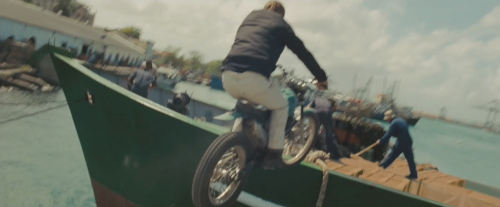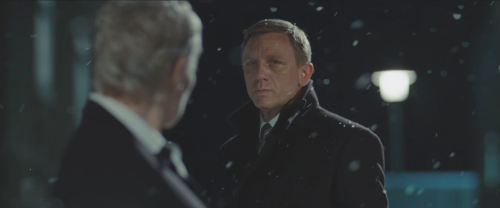Quantum of Solace (Marc Forster, 2008)
The new Bond film, Quantum of Solace, is a strange beast indeed. It aggressively imitates the rival Jason Bourne spy franchise; and yet despite that derivativeness, it somehow manages to impart a sense of renewal and vigour to the Bond series. In that sense it continues the work started by Casino Royale admirably. And while it doesn’t always feel like a Bond film, it does feels like those at the helm are actually concentrating – something that was missing in plenty of more identifiably “Bondian” entries in the franchise.
It starts mid-chase, in the immediate aftermath of Casino Royale, thus reviving the idea of film-to-film plotting that had been used (albeit more loosely) in the sixties Bond films. Bond is still smarting from the death of Vesper Lynd, and he’s following the leads she left him to try to find the organisation that was backing the previous film’s villain, Le Chiffre. Quantum thus gives a sense both of the film that should have followed the death of Bond’s wife in On Her Majesty’s Secret Service, and also of what the previous “renegade Bond out for revenge” film Licence to Kill should have been. It also very strongly echoes The Bourne Supremacy, right down to the icy Russian epilogue.
That it doesn’t bear many traits of the traditional Bond film oddly does not matter a great deal. Yes, the Bond producers are slavishly imitating their chief rival, even hiring the same second unit director (Dan Bradley) to helm the action scenes. But a certain déjà vu goes with the territory, and at least the producers seem to have been spurred by the Bourne challenge into seeking to reclaim their pre-eminence in the genre. Back in the sixties, the Bond films were the action series that all others imitated; they basically invented modern blockbuster filmmaking, and either Goldfinger or On Her Majesty’s Secret Service could legitimately be cited as the greatest action-adventure film of the 1960s. Yet the producers burnt that legacy with years of complacent films that simply did not stand beside the top action films of their era, put together by bottom tier directors such as John Glen. Watch For Your Eyes Only after Raiders of the Lost Ark; or Licence to Kill after Die Hard; or The World is Not Enough after The Matrix; and then try to tell me the Bond films were keeping up with their contemporaries. The Bond films still don’t lead the pack, and probably never will again, but the post-reboot Casino Royale and Quantum of Solace now actually look respectable against their competition.
Part of that is hiring good directors. They’ll never have a Bond film directed by a Spielberg-level superstar, but Marc Forster (director of Stranger than Fiction, Finding Neverland, and Monsters Ball) is an example of the kind of established, quality director who can bring something to the series. Forster’s work here shines in the expository and character-based scenes; he gives us a world that is real enough to not evoke a Spy Who Loved Me-style comic book detachment, and yet exotic enough to fit James Bond. And he does good work with the actors: Daniel Craig does his rough-hewn take on Bond again, as admirably as before, but this time his interaction with Judi Dench’s M is less forced and exhibits more natural chemistry. (The scripting, again by Paul Haggis and the team of Neal Purvis and Robert Wade, is much better in its depiction of the M / Bond relationship, which helps). Perhaps most notably, he’s willing to try ideas that would in the past have surely been rejected for a Bond film. This includes some unhappy innovations like foregoing the gun barrel opening, but also more successful ideas, like playing with intertitles and on-screen graphics, and intercutting one fight scene with the opera unfolding nearby. Forster did not use series regular Daniel Kleinman for the titles, instead hiring design firm MK12, and he seems to have had the group involved in designing elements within the film as well. He also makes good use of some very evocative locations and sets: in one startling moment late in the film, Bond seems to have pulled up at the train station from the opening of Once Upon a Time in the West.
The downside with Forster is that he’s not an experienced action director, and the similarity to the Bourne films is probably largely due to a heavy reliance on the Bourne veteran Dan Bradley to shoot the fight and chase sequences. This means the film suffers from similarly shaky camerawork and rapid-fire editing in its action, which detracts somewhat from otherwise exciting sequences. The relative incomprehensibility of the action is particularly disappointing after the staging in Casino Royale was so much clearer: I don’t consider Royale director Martin Campbell a top-flight action director, but he certainly had an admirable fondness for orienting master shots at key moments (think of that moment in the airport chase where he shows Bond rolling away from the tanker, or the many long shots in the opening foot chase). Quantum of Solace, by contrast, goes mostly for disorientation and shakiness, and there is one moment (the start of the opera fight) that I will need to see again to have any chance of knowing what happened. (I suspect the action will play much better on DVD, where the diminished screen size lets the eye scan the images faster). Despite this, however, the film is exciting, with a fight scene on a scaffold particularly well done, and almost Indiana Jones-esque in its delight in playing with pulleys, ropes, rotating beams and collapsing platforms. All of it is put over with percussive and suitably brutal score from long-time Bond geek David Arnold.
What I really liked about the film, though, is that the producers are finally making intelligent choices. The first one was the return to Fleming in Casino Royale. Quantum of Solace takes that in a different direction, further from Bond territory, but this feels valid given the nature of the story. It’s fun watching Bond use his wits in a scene in which he impulsively gets in a stranger’s vehicle and pretends to be someone he’s not: he did something similar in You Only Live Twice but its more plausibly and cleverly done here. And despite the stripped down narrative (as every review is dutifully noting, this is the shortest of the Bond films), the character is intelligently developed. Two elements particularly appealed to me. Firstly, Bond isn’t out for revenge quite as much as answers: I felt this showed a good appreciation by the filmmakers of Bond’s character. And secondly, as mentioned, the relationship between Bond and M doesn’t overdo the “renegade” angle, as I’d expected it might considering the plot. As I’ve said before, Bond has traditionally been distinguished from other action heroes by his deference to his boss – at least until the Roger Moore era, rank insubordination was not his style – and I felt the banter between M and Bond in Casino Royale descended into Hollywood cop movie silliness. Here, there is a lot of tension and Bond does disobey orders, but it’s well motivated, and the Bond’s gratitude to M is made clear at the end of the film. Instead of seeing Bond’s rebellion here as a schism, they seem to be setting up a reason for him to be fiercely loyal to M in subsequent films.
As in Casino Royale, there is a clear setup here for those subsequent films, and a sense of optimism that they will be worth seeing. Having had the lean-mean-rogue-agent version of Bond, I would enjoy seeing Craig in a more traditional mission-based Bond film. Of course, the series could go anywhere. The Bond producers are fickle: they could be following some totally different trend by the time the next film rolls around, and may well try to put Daniel Craig in a death ray from space movie. But for the moment, good Bond is back, and I’m loving it.
Related Items
My review of Casino Royale is here, and my article on Bond and Vesper is here.
To take it right back to the start with my review of Dr No, which explores a lot of what makes Bond cool, click here.


